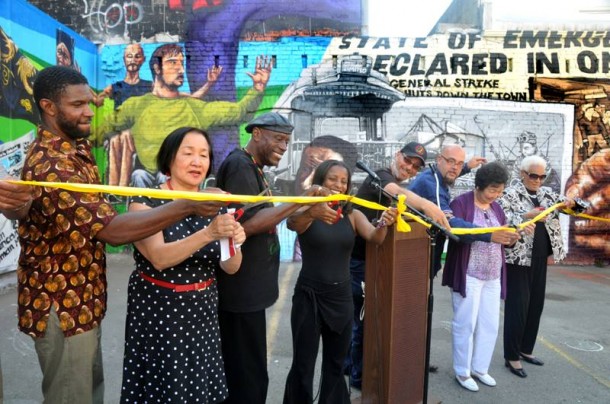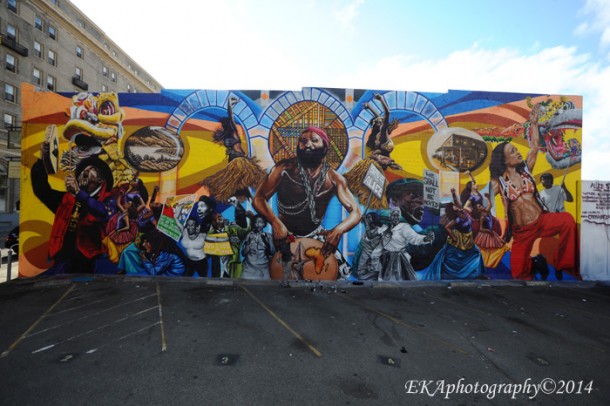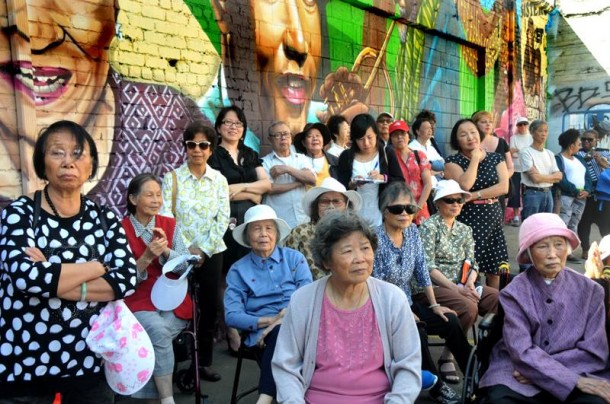
photo by Ted Kurihara
On Friday, August 8, 2014, CRP announced the completion of Phase I of the Alice St. Mural Project with a ribbon-cutting ceremony, held in the parking lot at Alice and 14th St., in front of two sections of the mural wall. The event, which was noted by the Oakland Tribune, the San Jose Mercury News, and KQED, was an overwhelming success, with over 120 attendees, including approximately 75 residents of the Hotel Oakland, along with neighborhood residents and artists-in-residence at the Malonga Casquelord Center for the Arts.

photo by Ted Kurihara
Several people featured on the wall were in attendance, including African American media icon Jerri Lange: musician Destiny Muhammad aka the “harpist from the Hood”: social justice activist , Cephus Johnson, director of the Oscar Grant Foundation; dance teacher Carla Service, founder of Dance-A-Vision; Oakland Chinatown historian Roy Chan, doctor of Chinese Medicine Yin Lin Liang, and dance teacher Lisi You. Oakland Mayor Jean Quan, honored on the wall with a picture of an Oakland Tribune headline celebrating her election as the nation’s first Chinese-American female mayor of a major city, was also on hand, as was Victor Luo, who translated remarks from English to Cantonese and vice-versa.
As CRP founder Desi Mundo explained, “this mural is a new model for community engagement as well as a new model for graffiti abatement. We want to see murals that reflect the community, that engage the community, that tell the stories of our community.”

photo by Eric K. Arnold/EKAphotography
Casey Farmer, a staffer for District Three Councilmember Lynnette Gibson-McElhaney – who first notified CRP about the mural site and have supported the project throughout the year-long creation process – called the project “remarkable,” noting that it replaced heavily-tagged walls. Kiazi Casquelord, son of legendary drummer Malonga Casquelord, noted that his father’s image – the centerpiece of one of the wall panels – represents “a large community… which could extend all the way to San Jose.” Service talked about how much the mural project means to her students, who are depicted on the wall performing an African Rites of Passage dance. She also noted how the mural reflects African culture and “the history that’s right here in Oakland.”
Johnson said he was “humbled and honored to be included in such a historical project which truly displays what Oakland is,” adding that the mural is an “extremely powerful” representation of cultural resilience which “spoke exactly to what our artists in Oakland are about.”

photo by Ted Kurihara
Some of the most poignant remarks were made by Lange, who was introduced by her son, Michael. The former broadcaster said “I’m very comfortable with this mural, because this is the way West Oakland looked when I was born there.” She recounted how she grew up in a diverse community of “Japanese, Chinese, Irish… all the different [ethnicities] that exist in this world.” The mural’s diversity, she noted, “ is the closest I’ve seen to returning to that kind of feeling about Oakland.
“This is what America is about. And America is now coming to the realization that this is who we are,” she exclaimed.

photo by Ted Kurihara
The project also resonated strongly with the Chinese-American community. As Liang noted, the mural “depicts the diversity of cultures in this community. It will attract a lot of residents and visitors and it will improve our community. Looking at this mural as a Chinese resident here, I can tell that Chinese Americans have contributed a lot to the diverse culture here… the Chinese came here, they built railroads. It also reflects the Chinese traditional culture, you can see lion dance, dragon dance, Chinese martial arts, calligraphy, and even traditional Chinese lifestyle, where you see the parents and kids all depicted in this mural. This large piece of art can effectively create a better living environment for this community.”
You added, “through this public art project, the community will become more beautiful and Oakland will become more beautiful.”

photo by Eric K. Arnold/EKAphotography
Mayor Quan said she was happy to see new murals go up in Oakland, noting that public art took a hit from the elimination of the redevelopment agency in 2012. The mural, she revealed, spoke strongly to her own history, as a fourth-generation Oaklander—her great-grandfather came to Oakland following the 1906 Earthquake—founder of the Asian American Studies program at UC Berkeley, longtime political activist, Oakland’s first Asian School board member, City Council person, and finally, mayor.
Looking at the words “remember 1882” on the wall, she said that “is a really important number for us. It shaped the whole Chinese American community. We were the only nationality that was ever excluded from America, that was the Chinese Exclusion Act. Because of that, the Chinese community was very small, it did not grow until after the san Francisco earthquake, it did not grow again, until the Kennedy immigration laws. It kept families divided.”

photo by Eric K. Arnold/EKAphotography
Quan went on to talk about the historical displacement of Chinese Americans (“Because they weren’t wanted, didn’t have a lot of political power downtown and other people wanted their land”). She pointed to a painting of a 19th century Chinese produce-seller carrying a pole holding a basket. “Even that pole, because the Chinese were so good at growing vegetables, they outlawed that pole so that they couldn’t bring their vegetables over to San Francisco,” she said.
One important piece was missing from the mural, she declared: a panel showing the women’s suffragette rallies, held at the current site of the Malonga Center more than 100 years ago. “This is where the suffragettes used to meet in the early 1900s to fight for the right to vote for women in California. And the only big parade for the suffragettes in California was here in Oakland. They organized out of that hall.”

photo by Eric K. Arnold/EKAphotography
What Quan didn’t say, however, was that in 1911, two Chinese-American women and Oakland residents, Emma Leung and Clara Lee, became the first Asian-American female registered voters in the country, after filing their paperwork at the Alameda County Courthouse – located just a few blocks from the mural site.
That scene may just have to go up during Phase II of the project, scheduled to be completed in September – which Quan pledged to help fund. More donations are needed, however – not only to finish all four walls of the mural, but for the video documentary project, directed by Alice St. resident Spencer Wilkinson, which features extended interviews with neighborhood residents. (To help fund Phase II and the documentary, click here.)

